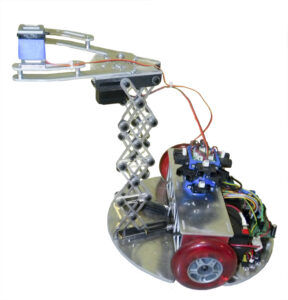
HARTFORD, CT – RoboWaiter, one of this year’s Senior Design Teams in Mechanical Engineering and advised by Dr. Stacy Bamberg, won several awards in the advanced division of the Trinity College RoboWaiter Competition. The competition took place on March 31 and April 1, 2012, in Hartford, Connecticut. The team placed second in the Senior Division of the 2012 Olympiad Exam, third in the RoboWaiter Advanced Division, and earned the Spirit of the Inventor Award.
The goal of the competition was to autonomously drive a robot around a miniature course simulating a kitchen while avoiding obstacles. These obstacles, a grandma doll and a chair, could be placed anywhere in a general area of the course. One of two possible pitches (one high and one low) sounds the start of the match, triggering the robot to activate a sensor on the refrigerator to open the door. The starting pitch signaled the robot to retrieve a plate from either the upper or lower shelf (depending on the pitch). The robot then needed to close the refrigerator door and take the plate back to a grandpa doll waiting in a wheelchair to receive his food. The robot then would navigate back to its starting position. At the sound of the second buzzer, the robot would retrieve the plate from the table, take it to the sink, and return to its original location.

The University of Utah team placed third in the robot run section, and earned second place in the written robotics exam. The exam was taken by three of the six team members – the only ones that were able to fly to Connecticut for the competition – and include Nicholas Fugal, Sam Wright, and Brandon Norton. The exam was very challenging and tested concepts in many robotics facets. The Spirit of the Inventor award, granted to only one team out of 127 participating teams, is “the award we’re most proud of,” said Brandon Norton, one of the RoboWaiter team members. “We received it in recognition for the creative design of our robot.”
The creative design of the University of Utah team includes a “unique scissor lift and sensor cluster.” The team used two rotating motors to lift a “grabbing platform” to various heights using several links and a lead screw. “The idea of a scissor is lift is nothing new,” said Norton, “but it was new to the competition. This was viewed as an inventive way of solving the problem at hand, with creativity and ingenuity being some of the main reasons the competition was created.”
The team’s “sensor cluster” was a group of sensors clustered tightly together so that all sensors measured from the same point, which allows for greater expandability for future projects. This idea was unique because most other robots had sensors spread around their robot to give it a better chance of finding an obstacle. The RoboWaiter’s sensor cluster required a significant amount of trigonometry and geometry to compute the same information, which will eventually allow the robot to start from any location on the course, gaining them extra points with the judges.
The purpose of the Trinity College RoboWaiter Competition is to raise awareness for and to develop robots for the elderly and persons with disabilities. This technology may one day help those people to be more independent as even the act of getting a plate of food from the refrigerator can be a daunting task when a caregiver is not present. “Assistive technology,” said Norton, “though still in it’s infancy, can be a huge leap forward in the quality of life for these people.”